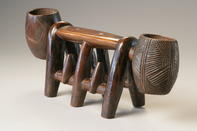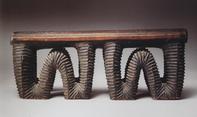Colony of Natal Period: 19th century Material: wood Height: 14.1 cm, Length: 39 cm Some of the headrests collected in the Colony of Natal before the 20th century have bulbous legs that some rural owners referred to as amasondo, or legs of a cow.

This headrest also has finely worked colour contrasts introduced by blackening the legs and the underside of the platform in pokerwork. Among the 20th century inhabitants of the Msinga region of KwaZulu-Natal, incised patterns like these were referred to as ndlela ziyegolo, meaning the way or road to Johannesburg.

Colony of Natal Period: 19th century Material: wood Height: 15.5 cm, Length: 39 cm There are a significant number of headrests combining horn-like legs with elaborately carved bowls in different public and private collections.
Many of these were collected in the mid-nineteenth century in the Colony of Natal, and some have been ascribed to a single renowned carver.
It is difficult to ascertain what function these bowls would have served. Some Tsonga and Zulu headrests have small snuff-boxes incorporated into their support structures, presumably because of the belief that snuff facilitated communication with the ancestors. Although this is the most likely explanation for these bowls, they normally had lids to prevent the snuff from being spilled or scattered.

Colony of Natal Period: 19th century Material: wood Left: H 16 cm, L 21 cm, Centre: H.21 cm, L 68.5 cm Right: H 12 cm, L 20 cm Some unusually large headrests were produced for display at colonial trade exhibitions. Both the sides and the base of the example in the middle are decorated with repeated rows of impressed triangular patterning.
Decorative embellishments like these are also found on other headrests intended for this market, such as the example on the left. Some carvers working for colonial agents used relatively soft woods that could easily be incised with the aid of a metal punch.
But as the patina and wear on the example on the right suggests, some of these headrests may also have been sold to local patrons who, through constant use, would have changed their appearance, enriching their surfaces with natural hair and body oils.

Colony of Natal Period: 19th century Material: wood Height: 16.5 cm, Width: 41.5 cm As is common with some large wooden vessels produced in the Colony as early as the 1840s, the legs of this headrest is covered in scalloped patterns.
Although virtuoso carvings of this kind were made as prestige items for indigenous patrons, they also ended up on colonial exhibitions in France and the UK. The name of at least one of these skilled carvers was documented as Unobadula by Dr Robert Mann, Superintendent for Education in Natal from 1857 to 1868.
By Professor Sandra Klopper